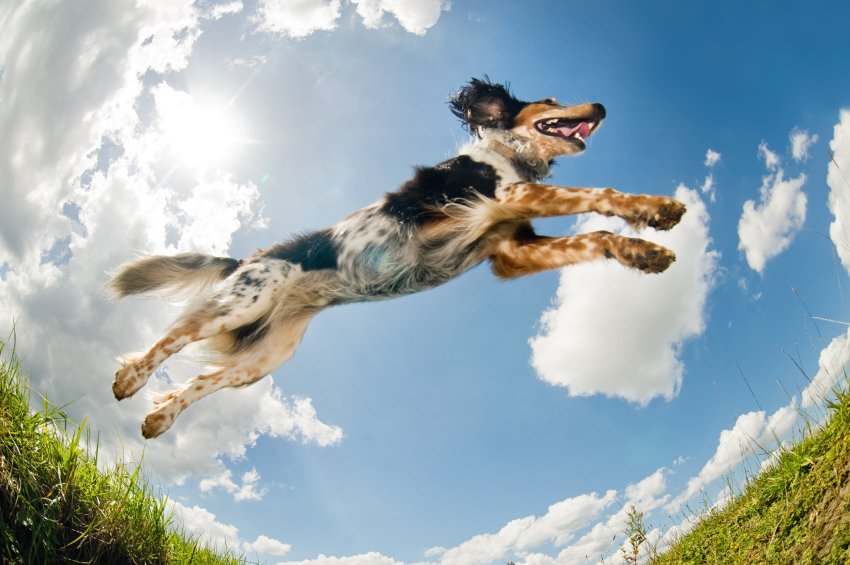Laurie's Blogs.
Oct 2016
Plyometrics with a side plate of humour

Looking through the weekly blog synopsis that I have collected and compiled for me, I found one on plyometrics. Now, the blog was for people, but I know that I’ve presented info on canine plyometrics, and I have seen a few blogs on canine plyometrics… so I thought I’d do an additional search on “Canine Plyometrics” and I found a series of articles / blogs on plyometrics you can do with your dog. My goal is to enlighten and entertain you with this blog on plyometrics based on some of the things I read! Let’s dive in!
Plyometric exercises are not only good for jumping. This type of training is a combination of strength and speed. Plyometrics is defined as a “quick, powerful movement involving pre-stretching the muscle and activating the stretch-shortening cycle to produce a subsequently stronger concentric contraction.” Think of trying to jump up onto a stool or step. First you bend your hips, knees, and ankles (stretching the glutes, quads, and gastrocs) and then you explosively contract those muscles in order to propel yourself upwards and onto the step. But plyometrics also improves one’s ability with sudden changes in direction, or landing from a jump and then taking off again, or throwing something heavy, or catching something heavy, or jumping rope, etc.
Why plyometrics?
What happens with training in plyometrics is that before you see growth in the muscle fibres, you get development of more efficient neural pathways. So, if you already have a certain amount of fitness, plyometrics and bust you out of a training plateau, leading to even greater neuromuscular efficiency (i.e. greater force output & increased control of contracting muscles). All of which translates into better strength, speed, power, and skill.
Before you begin, it is critical that you ensure that the dog has enough general strength to handle 10 – 15 minutes of any kind of exercise. The dog should have adequate joint range of motion and muscle flexibility, so that doing plyometrics won’t cause an overstretch injury. He or she should have acceptable balance and proprioception… again, a wee bit of pre-conditioning is needed before you begin plyometrics. Lastly, consider the dog’s weight (too heavy could be harmful), age (too old or too young might not have enough base-line conditioning), coordination (inadequate body awareness could lead to injury), and the owner’s knowledge (can the owner safely supervise). If all things align, then you can try adding some plyometric exercises to the dogs training regime.
Warm up first! Five minutes of gradually increasing heart pounding should be sufficient to get blood pumping.
Plyometrics for dogs:
- Hopping over jumps (low and easy to start). Perhaps set up 3 jumps, space about 2-dog-lengths apart. Start with jumps that are about ‘carpal-height’ for your dog. Ensure good, non-slip footing is available. Work up to higher jump heights (without getting too crazy).
- Jumping onto a platform. Start low, and ensure that the take-off and landing zones are all non-slip. This works the rear legs more that the forelimbs.
- Jump off the platform. This works the forelimbs more than the rears.
- Keep away, tag, or ‘soccer’ are also ways to play with your dog that have a plyometric component.
General tips: Start with only one (or two) plyometric exercises, and limited repetitions (i.e. 3 - 5). From there, you can build and add. Remember, the rule of thumb is to increase one component of a conditioning program at a time. You can add to duration, frequency, reps, sets, difficulty, types, or numbers of exercises to a regimen. Just be sure that there have not been any ill effects to what you have added by keeping your program steady for 4 – 7 days before adding something else new.
Now for the humour. I found a funny blog series on ‘Slimdoggy’, that talks about exercising with your dog. The creator has a couple of blogs on plyometric drills to do with your dog. So, here are his suggestions for training YOU and your dog with plyometics:
- Hopping: Hang out with your dog, and jump. Do several jumps in a row. Encourage your dog to jump along with you. If he or she won’t then just get them to come to you between jumps.
- Medicine Ball Slams: Feet apart, raise the ball over your head. Slam the ball to the ground. Most importantly, train your dog to sit in an area where you will not be slamming the ball. Use caution so that you do not slam your dog with the medicine ball! (Let's just say I won't be trying this with my nutty crew of dogs!)
- Tummy rubs (for the dog) should be administered at the end of the exercise session.
Actually, it’s rather a cute blog all around.
So there you go for this Monday! Go out there and ‘jump, jump, jump around’!
Until next time, CHEERS! Laurie
References:
- http://fitnesspainfree.com/training-program-include-plyometrics-jumping/
- http://totofit.com/canine-plyometrics-maximizing-power/
- http://slimdoggy.com/plyometric-drills-with-your-dog-update-ball-slams/?utm_source=feedburner&utm_medium=feed&utm_campaign=Feed%3A+SlimdoggyFitness+%28SlimDoggy+%C2%BB+Fitness%29
- http://slimdoggy.com/beginner-plyometric-drills-to-do-at-home-with-your-dog/


